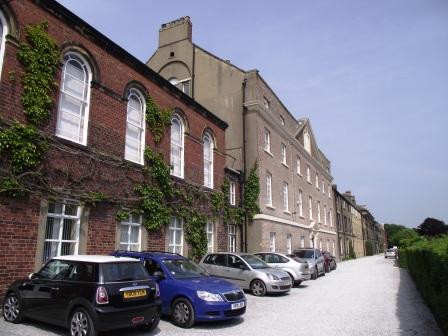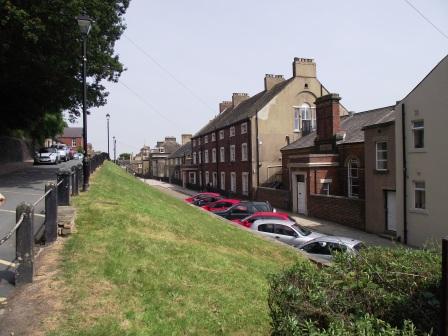In 1743 Count Zinzendorf was on his way to visit one of the religious societies formed by clergyman Benjamin Ingham. Ingham was a preacher who would find followers in Churches, houses, barns and fields, and he formed religious societies wherever he went. A year earlier, Ingham had offered his West Riding societies to the stewardship of the Moravian Church and the thousand or so members had gladly agreed. At this time, ministers from the Moravian Church were sent out to the societies.
Zinzendorf, a Saxon Nobleman, had become a prominent figure in the Moravian Church (then know as the Unitas Fratrum, which means Unity of Brethren) when their group took refuge on his land in Herrnhut in 1722. Zinzendorf was most likely coming over to meet with Brother and Sister Gussenbauer who had being assisting with the work of the Pudsey Society and now needed a new centre.
It is noted that as Zinzendorf looked northwards across the green valley of Tong, towards Pudsey, he “had such a sweet feeling and deep impression of the place, that he immediately determined it should be the site of the Moravian settlement, similar to that of Herrnhut, and that it should be named ‘Lambshill’.”
The area he was referring to was actually known as ‘Fallneck’ and the moment was opportune as the 22 acre estate was up for sale by the owner, William Moss. Ingham learned that Moss was in a hurry to sell. He negotiated the asking price down from £1130 to £905 and then leased the land to the Moravian Church.
The name ‘Fulneck’ replaced the chosen name of ‘Lambshill’ and the local name of ‘Fallneck’. Fulnek was the hometown in Moravia of the famous educator and Bishop of the Unitas Fratrum, Jan Amos Comenius.
The foundation stone of the present Church was laid in 1746 by John Toltschig and the Church was named Grace Hall. It was completed in 1748. Shorty afterwards, there was the building of the ‘Choir Houses’ for the Single Sisters and the Single Brethren either side of Grace Hall.
The settlement was virtually self-sufficient with it’s own blacksmith, bakery, shop, tailor, shoemaker and doctors. The Sisters would work as spinners and later embroiderers. The Brethren would weave and dye cloth.
Choir Houses
On one side of the Church was the Single Sisters’ house where single women, widows, infants and small children lived, worked and slept. On the other side of the Church was the Brethren’s house where men, widowers and young boys had the same arrangement.
In the early years, marriages were arranged. A possible match between the Sisters’ and Brethren’s Houses was put to The Lot, as it was believed that the answer would reveal the Saviour’s will. A question would be proposed and one of three small tubes was chosen. The papers inside read ‘Yes’, ‘No’, and the third one was blank. If the blank paper was chosen, the question was asked again another time, in a slightly different form. If the answer was ‘Yes’ the proposed couple was allowed to give their consent or withdraw from the arrangement. Widowers were encouraged to remarry, and the availability of married accommodation determined the frequency of marriages.
Burial Ground
The burial ground is affectionately known as ‘God’s Acre’ and was consecrated in 1749. It is the resting place for the members of the Fulneck congregation. The gravestones are a simple, flat stone, no bigger than one and a half feet wide, laid horizontally in rows.
Moravian Church customs during this period were slightly unusual to the local people. For instance, the Moravians would not wear mourning clothes, they would follow the coffin from the church to God’s Acre blowing horns, and immediately after the death some of the men would sing requiems for the dead in the bell tower of the Church.
One of the traditions that continues today is the Easter morning service. The service begins in the Church and then the congregation walk to God’s Acre for prayers and to name the members of the Congregation who have died in the past year. This short act of remembrance closes with the singing of a hymn and then the congregation share breakfast together.
Fulneck School
Moravian Church ministers, known as ‘Labourers’, moved around congregations and throughout the world in their missionary work. Their children were cared for in the children’s oeconomies.
In 1753, twenty-five boys arrived at Lambshill having travelled from Wyke, their previous home, by cart and by foot. They were welcomed by the sound of trumpets blowing from the roof of Grace Hall. They were educated in the rooms under Grace Hall and slept in the garrets. In 1755, the girls arrived in a covered, horse drawn wagon and were accommodated in a similar fashion, with partitions separating the boys’ school and the girls’ school.
The Moravian Church placed great importance on the education of children. Several centuries earlier Jan Amos Comenius (1592–1670), Moravian bishop and educator, had said, “Children must learn not only words, but also objects along with words. Not memory alone ought to be cultivated, but reasoning power, the will and the affections. Children should be taught to think clearly, at the same time a caring communication with them should be kept up.” He devised a ‘graded’ educational system, introduced pictures into text books, and devoted himself to providing new and inspiring educational material for children, writing 154 books. The curriculum at Fulneck included Geography, English Grammar, Writing, Reading, Bible History, German, Latin and Greek. Music featured highly with lessons on the spinet, harpsichord and guitar.
The fortunes of the schools and the Settlement fluctuated over the years that followed and financial problems often occurred. Eventually in 1804 the schools became boarding schools and fee-paying children were accepted. Again the fortunes of the schools wavered due to the trade depression of the 1840s and a typhoid epidemic in 1878. The twentieth century saw the biggest growth in the schools. New buildings, including a new science block, dining room, dormitory blocks and increased classroom space, accommodated the swelling number of day and boarding pupils. In 1992 the girls’ and boys’ schools merged to become Fulneck School. Today there are around 300 pupils from ages 3 to 18 years old.
To find out more about Fulneck School today use the link below.
Why not try our Meditation Walk?







